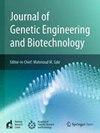Comparative proteomics and structure-based approach to unravel the therapeutic drug target of Theileria species
IF 2.8
Q3 Biochemistry, Genetics and Molecular Biology
Journal of Genetic Engineering and Biotechnology
Pub Date : 2025-04-10
DOI:10.1016/j.jgeb.2025.100488
引用次数: 0
Abstract
Theileriosis, caused by protozoan parasites of genus Theileria, primarily affects both domestic and wild ruminants. It can lead to significant economic losses in livestock farming due to decreased productivity and high mortality rates in susceptible animals, while treatment measures are not cost-effective. Since most of mechanisms of this disease remain unknown, this study investigates the differences in the mode of pathogenesis between transforming and non-transforming groups through an in silico comparative proteomics approach to recognize the key players involved in host cell transformation. Although the major biological processes and molecular functions are almost conserved between the two groups, PEST-motif containing secretory proteins of SfiI, SVSP, and Tash-AT gene families were identified as important candidates with the potential to transform infected host cells. Several members of PEST-motif containing proteins possess signal peptides, nuclear localization signals, and trans-membrane helices, further supporting their potential to transform host cells. Additionally, structural analysis helped in the identification of a parasitic protein (SfiIp) from SfiI family as a plausible drug target. Virtual screening revealed FDA-approved drugs (i.e. atogepant and rimegepant) as promising compounds, showing the highest affinity for SfiIp during molecular docking. Further studies, including molecular dynamics simulation, principal component analysis, and free energy landscape, suggested that these drug molecules exhibit the stable interaction with protein. Therefore, our research could facilitate the identification and targeting of novel drug candidates that may be further implemented to recognize effective therapeutics against Theileria infections.
比较蛋白质组学和基于结构的方法揭示其治疗药物靶点
黑僵菌病是由黑僵菌属的原生动物寄生虫引起的,主要影响家养和野生反刍动物。由于生产力下降和易感动物的高死亡率,该病可导致畜牧业的重大经济损失,而治疗措施不具有成本效益。由于该疾病的大多数机制尚不清楚,本研究通过计算机比较蛋白质组学方法研究转化组和非转化组之间发病模式的差异,以识别参与宿主细胞转化的关键参与者。尽管两组之间的主要生物学过程和分子功能几乎是保守的,但含有SfiI, SVSP和Tash-AT基因家族分泌蛋白的PEST-motif被确定为具有转化受感染宿主细胞潜力的重要候选基因。一些含有pest motif的蛋白成员具有信号肽、核定位信号和跨膜螺旋,进一步支持它们转化宿主细胞的潜力。此外,结构分析有助于从SfiI家族中鉴定出一种寄生虫蛋白(SfiIp)作为可能的药物靶点。虚拟筛选显示fda批准的药物(即atogetant和rimegetant)是有前途的化合物,在分子对接过程中对SfiIp表现出最高的亲和力。进一步的分子动力学模拟、主成分分析和自由能分析表明,这些药物分子与蛋白质具有稳定的相互作用。因此,我们的研究可以促进新的候选药物的鉴定和靶向,这些候选药物可能进一步实施,以识别对抗伊氏杆菌感染的有效治疗方法。
本文章由计算机程序翻译,如有差异,请以英文原文为准。
求助全文
约1分钟内获得全文
求助全文
来源期刊

Journal of Genetic Engineering and Biotechnology
Biochemistry, Genetics and Molecular Biology-Biotechnology
CiteScore
5.70
自引率
5.70%
发文量
159
审稿时长
16 weeks
期刊介绍:
Journal of genetic engineering and biotechnology is devoted to rapid publication of full-length research papers that leads to significant contribution in advancing knowledge in genetic engineering and biotechnology and provide novel perspectives in this research area. JGEB includes all major themes related to genetic engineering and recombinant DNA. The area of interest of JGEB includes but not restricted to: •Plant genetics •Animal genetics •Bacterial enzymes •Agricultural Biotechnology, •Biochemistry, •Biophysics, •Bioinformatics, •Environmental Biotechnology, •Industrial Biotechnology, •Microbial biotechnology, •Medical Biotechnology, •Bioenergy, Biosafety, •Biosecurity, •Bioethics, •GMOS, •Genomic, •Proteomic JGEB accepts
 求助内容:
求助内容: 应助结果提醒方式:
应助结果提醒方式:


